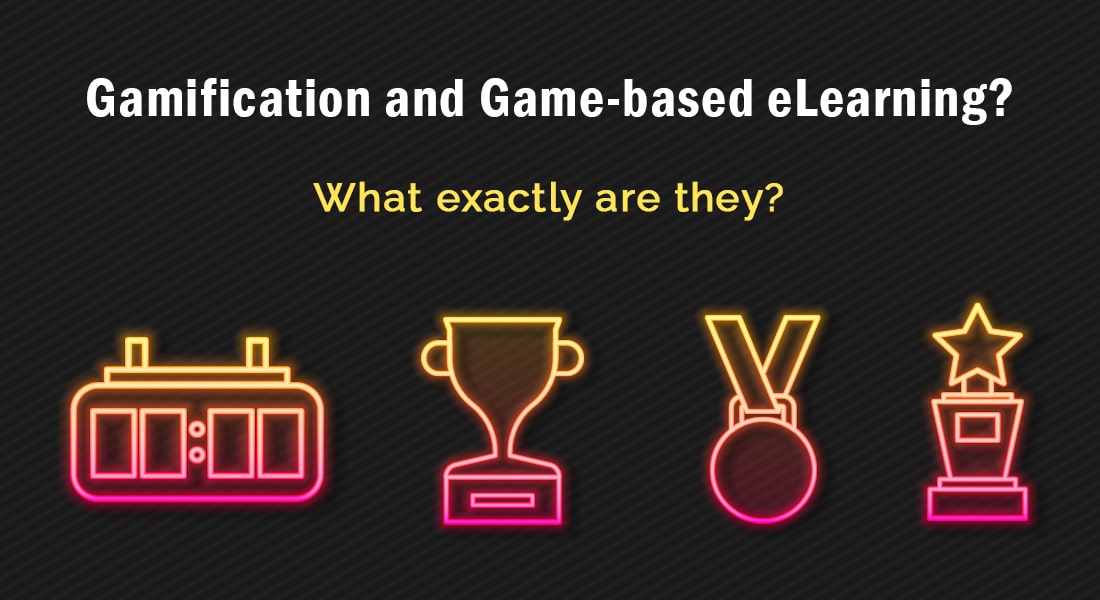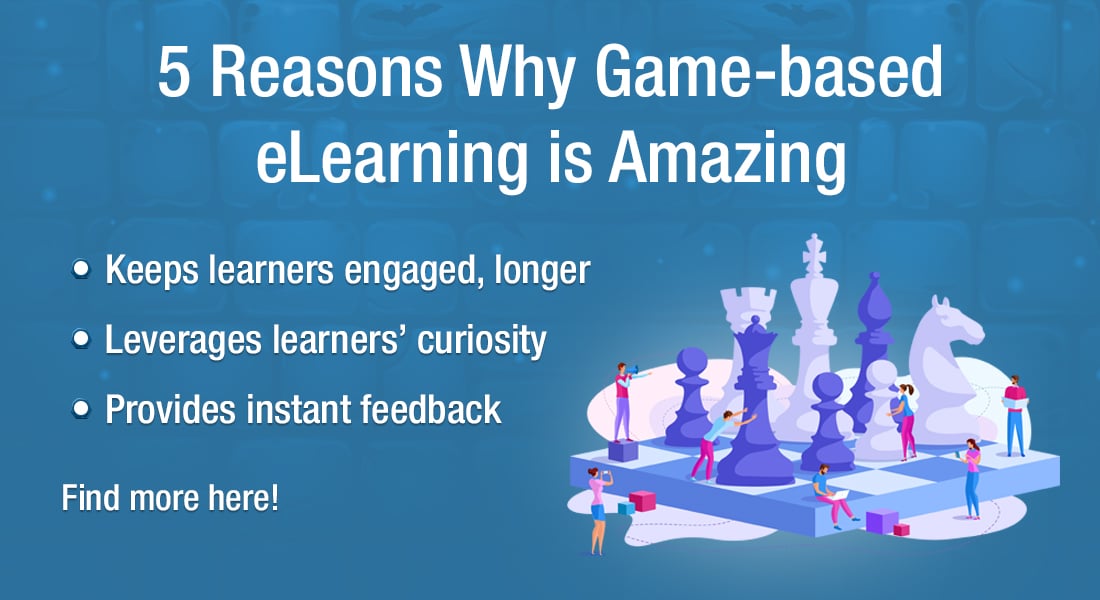Decoding Game-based Learning Courses in Online Training: What and How

In online training, engaging your learners is an imperative factor to ensure effective transfer of knowledge to the job. E-learning courses use varied media elements such as videos, animations, and more to captivate learners’ attention. However, these conventional methods of knowledge transfer have one thing in common – a one-way-exchange of information. Though you can include eLearning interactivities, they still limit learners’ participation in the learning process. Meanwhile, game-based learning courses weave learning content around a game. This allows learners to gain knowledge while playing, ensuring knowledge transfer is effective.
What is Game-based Learning?
Game-based eLearning courses integrate games into the learning process where learners have to play to learn and achieve specific learning objectives. Learners get the opportunity to apply their knowledge while playing, in contrast to gaining contextual knowledge first and putting it to use later.
What is Game-based Online Learning?
The very principle of game-based online learning hitches on the Situated Cognition theory which posits that knowing is inseparable from doing. Game-based eLearning courses integrate games into the learning process where learners have to play to learn and achieve specific learning objectives. The theory argues that knowledge is situated in the context, activity, and culture in which it is learned.
To put it simply, learners get the opportunity to apply their knowledge while playing, in contrast to gaining contextual knowledge first and putting it to use later. Consequently, learners who gain knowledge this way retain information much longer, since they actively discover learning, not passively.
Needless to say, game-based eLearning content encourages learners to solve problems, exercise their imagination, execute strategies, play as characters, and win the game. Much like the famous game PUBG that has managed to attract even non-gamers, game-based eLearning courses ensure effective knowledge transfer and improved application to the job.
Also, game-based eLearning courses intrigue learners and promote self-esteem, social interaction and of course, fun. However, are game-based eLearning courses the same as gamified eLearning courses or gamification in online training?
Are Game-based and Gamified eLearning Courses the Same?
Gamification is not game-based eLearning. In fact, gamification does not require learners to even play a game. Gamification is all about using game mechanics and elements such as badges, rewards, points system, and ranking, to make learning compelling. (For instance, giving two points for each correct answer.)
Gamification or gamified eLearning courses posit on encouraging learners to engage in a desired manner while taking advantage of the human psychological tendency toward gaming.
Game-based courses, on the other hand, use full-fledged games to achieve specific learning objectives in eLearning. For instance, an eLearning course designed in the form of a maze where learners have to figure out the right way by overcoming all hurdles successfully.
What are the Important Elements of Game-based eLearning Courses?
While game-based eLearning courses have to be engaging and compelling, learning objectives around which the game will be designed are the star here. The game should gear up learners to achieve those learning objectives and provide important takeaways that enhance learning behavior.
A game-based eLearning course should be highly interactive so that learners are completely immersed in it. Moreover, everything in the game-based eLearning course starting from the narrative and background images and sound effects to the challenges and progression should be tied to the learning objectives and not work in isolation.
Game-based eLearning courses shouldn’t be too easy to win, which can bore learners and disengage them. Also, when a game-based online course is overly challenging, it can be frustrating and demotivate learners from progressing through the next levels. Hence, it is important to analyze your learners’ skills and experience levels to provide a course that caters to their learning needs.
Providing immediate and diagnostic feedback is an important component of a good game-based eLearning course. Feedback guides learners toward the right learning path and reinforces the right learning. For instance, consider a game-based eLearning course in the form of a board game. If the learner answers incorrectly, he may have to go back a few paces or draw an extra card and play again.
Game-Based Online Learning Courses: How We Did It
While you know what a game-based eLearning course is and what its important components are, it’s time to know how game-based eLearning works! Here are a few examples of how we developed game-based eLearning courses to meet our clients’ demand for active, engaging, and compelling learning.
Food Safety Hazards
For an eLearning course on food safety hazards, we decided a game-based approach to teach food safety practices to employees. The reason being, a mandatory course on food safety practices is often resisted by learners and hence it was important to attract their attention and keep them hooked throughout the learning process.

Click here to see the course
In this game-based eLearning course, learners have to first identify the hazards to food safety in the kitchen and then give reasons of it being so. The use of appropriate colors, compelling backdrop, and animated setup instantly attracts learners’ attention.
In this game-based eLearning course, learners are free to navigate, which allows them to learn the way they prefer, making them feel they are in charge of their learning. Consequently, it helped in raising the engagement quotient of the eLearning course.
Additionally, learners had opportunities to discover information in the online game-based course. How? Learners had to explore the hidden hazards in the kitchen and learn more about them by clicking them. Feedback was immediate and diagnostic, which enabled learners reinforce the right information and retain it for long.
Game-based eLearning Assessments
While the above example is a complete game-based eLearning course, eLearning assessments can be game-based as well. If your organization wants to quickly evaluate learners’ knowledge acquisition without making it dull, boring, and intimidating, you can go for game-based eLearning assessments!
One of the biggest benefits of game-based eLearning assessments is that they are developed to test employees in a stress-free environment. Evaluation in a low-pressure setting allows for more accurate performance and eliminates the tension of a conventional assessment.
Game-based eLearning assessments can either be part of your eLearning curriculum or work as a standalone module that can be used to evaluate learners, after the completion of larger online or classroom training sessions. Gaming fosters motivation, and the challenges and tasks further make assessments effective.
For instance, game-based eLearning assessments can be used to assess learners on compliance training topics such as safety or information security. You can even assess your time-stricken sales force in an engaging and interactive game-based assessment about the latest features of a product or the market policies.
Here are two examples of game-based eLearning assessments that we’ve developed. Go ahead and check the demos to know how they work. Both these game-based eLearning assessments assess employees on customer relations. The first is in the form of quiz while the second is a board game. Learners play this game while identifying dissatisfied customers and learn how to best deal with them.
By now, I’m sure you’re convinced of how game-based eLearning courses can take your training one notch higher. The effectiveness of these courses is pretty evident. However, in case you’re wondering if tracking eLearning activities is going to be a hassle, here’s good news.
The latest eLearning technology standard, xAPI allows you to track and record instances such as time spent on a course, number of attempts, errors made, pace of progress, and much more. To conclude, game-based eLearning courses are soon going to play a prominent role in shaping the course of online learning. Is your organization ready for it?
While game-based eLearning courses are surely trending, do you want to know more about what’s trending in eLearning? Here’s an eBook on “eLearning Trends 2019: The View from the Trenches” that can be downloaded for free. Explore this handy guide to know the trends and more!





